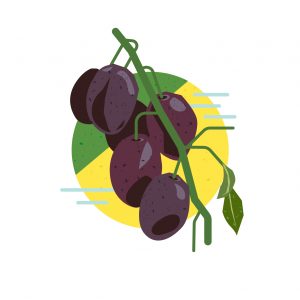LOCAL PLUMS

Plums can be added to salads or placed on the salad bar. Add them to your recipes for baked items or cut them up in a fruit salad. Use them on the breakfast line or in a breakfast recipe, or serve them as a snack. Plums make a sweet taste test item!
Agriculture Facts:
- Plum has many species, and taxonomists differ on the count. Depending on the taxonomist, between 19 and 40 species of plum exist. From this diversity, only two species, the hexaploid European plum (Prunus domestica) and the diploid Japanese plum (Prunus salicina and hybrids), are of worldwide commercial significance.
- Plum trees are grown on every continent except Antarctica. They are most commonly planted in temperate zones.
- Plums are delicious fruits that belong to the genus Prunus (stone fruits). The plum is a drupe or stone fruit, meaning its fleshy fruit surrounds a single hard seed.
- The average lifespan for cultivated plum trees is 10 to 15 years.
- Wild Plum trees actually had thorns, but man has bred that out of domesticated Plum trees.
Nutrition and Food Facts:
- In a 100-gram (3.5 oz) amount, raw plums supply 46 calories and are composed of 87% water, 11% carbohydrates, 1% protein, and less than 1% fat.
- Plums contain an assortment of healthy components, vitamins, and minerals. They are an excellent source vitamin C. Plums are also a good source of vitamin A, vitamin K, vitamin B1, B2, B3, B6, B9 and vitamin E. The minerals present in them include potassium, fluoride, phosphorous, magnesium, iron, calcium and zinc. They are also filled with dietary fiber, sorbitol, and isatin.
- The health benefits of plums include relief from indigestion, influenza infection, and anxiety-related problems.
Literature and Lore:
- They may have been one of the first fruits domesticated by humans. Plum remains have been found in Neolithic age archaeological sites along with olives, grapes, and figs.
- Plum pudding never had fresh Plums in it — it had dried Plums in it — i.e. prunes.
- The Damson Plum is believed to be the oldest variety of Plum. It was grown in ancient Mesopotamia. Some say it may have been grown in the Hanging Gardens of Babylon.
- Damson comes from the Latin word, “damascum”, meaning “Plum of Damascus”.
Spread the word and build partnerships
Don’t be a solo act. Invite your community to the table!
Promote in-house:
- Announcements
- Newsletters
- Website
- Social media
- Events (health fairs, open houses, garden working events, back to school, holiday activities, parents night, sporting events)
- Meetings (PTO, wellness committee, board of directors, staff professional learning days)
- Food tastings during events
Promote in your community:
- Report on activities and share pictures with news sources
- Share with community partners for their websites, social media and newsletters
- Post fliers at public places (libraries, health centers, non-profit hospitals, garden groups, local farm hubs, farmers markets, health agencies)
- Ask students to create and publicize local food stories – include photos or create videos
Invite others onsite to get involved:
- Build impact by engaging culinary arts, Future Farmers of America, wellness, botany, ecocentric and garden programs
- Create relationships and engage non-profit hospitals, garden groups, local farm hubs, farmers markets, health agencies and advocates
- Find support in local culinary leaders and businesses
Curricular Connections and Activities
K-12:
- FoodMASTER: Fruits from Ag in the Classroom for grades 3-5. Activity 3 focuses on plums; click here to view the lesson.
Menu Logos – right click to save these images


Recipes
We have many recipes for you to look through in our Recipe Index! Here you can see take-home recipes for use in the community as well as more choices for your cafeteria. You will find hot and cold recipes for most foods. Be sure to use the provided icons on your menu!
Featured Food Service Recipe: Kohlrabi Chicken Salad with Roasted Plums
Featured CACFP Recipe: Plum Perfect! Oven French Toast
Featured Home Recipe: Plum Crisp
